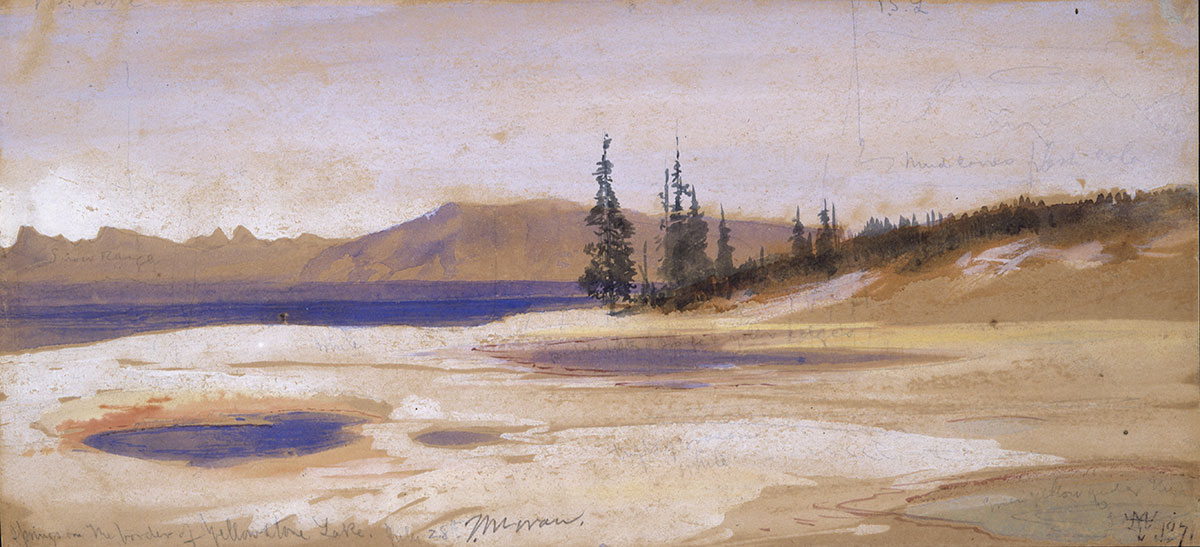Scenes of Transcendent Beauty: Thomas Moran’s Yellowstone
May 14, 2022 - August 23, 2022
Thomas Moran’s fascination with Yellowstone started in late 1870. Although verbal descriptions of Yellowstone’s landscape had been shared by explorers in the first half of the 19th century, they were too implausible—boiling mud and pools, water shooting skyward from the ground, kaleidoscopic hot springs, mineral terraces—to be believed. In 1870 though, Scribner’s magazine tasked one of its staff illustrators, Moran, who had never seen Yellowstone but was a promising young artist, to create illustrations of the area. Moran was charged with improving the rough sketches of members of an 1870 expedition to the region. His final illustrations, accompanied by a first-hand account of the expedition written by member Nathaniel Langford, were published in the May and June 1871 issues of Scribner’s. In these articles, Langford described Yellowstone as “some of the grandest scenery on the continent.”
Moran’s illustrations piqued not only the attention of the nation, but also the admiration of Jay Cooke, financier of the Northern Pacific Railroad, who had a vested interest in promoting America’s western territories. It was largely Cooke’s endorsement of Moran that secured his assignment as a painter on the first official expedition into Yellowstone, the Hayden Expedition of 1871. Cooke touted Moran as a “rare genius.” For his support, Moran pledged to return to Cooke 12 watercolors of Yellowstone. Upon seeing Yellowstone with his own eyes, Moran and his fellow explorers on the Hayden Expedition struggled for the words to describe the breathtaking scenes of “transcendent beauty.” This phrase comes directly from Moran’s own writings and serves as the inspiration for this exhibition.
This exhibit is our celebration of 150 years of Yellowstone. It explores the impact of Yellowstone on Moran’s career and his life, and will examine how his dramatic portrayals of landscapes helped to promote ideals of the American West. Scenes of Transcendent Beauty includes 20 watercolor field sketches on loan from the Yellowstone Heritage and Resource Center in Gardiner, Montana. These intimate sketches provide a rare window into Moran’s artistic process and give the viewer insight into Moran’s Yellowstone.
NATIVE AMERICAN PEOPLE IN YELLOWSTONE
Some have speculated that through his inclusion of an Indigenous person with key figures of the survey party, Moran alludes to the presence of Native Americans who were already in Yellowstone before the Hayden expedition. From the visual evidence in his painting Great Hot Springs Yellowstone National Park it does appear that the key members of the expedition are consulting with a Native person who knew the area well.
Historically, many tribes spent time and hunted in the area that became Yellowstone. The earliest evidence in a spear point found near the north entrance that dates to the Clovis culture (10,000 to 9,000 BCE). Later artifacts show that the number of people in the area increase and became more diverse. Most archeological sites date from 8,000 to 1,800 years ago. However, Indigenous people were eradicated from Yellowstone after the park was established in 1872. Scholars now believe that over thirty North American tribes had migration routes through Yellowstone. The following twenty-seven federally recognized groups have been identified:
- Assiniboine and Sioux
- Blackfeet
- Cheyenne River Sioux
- Coeur d’Alene
- Comanche
- Colville Reservation
- Crow
- Crow Creek Sioux
- Eastern Shoshone
- Flandreau Santee Sioux
- Gros Ventre and Assiniboine
- Kiowa
- Little Shell Chippewa
- Lower Brule Sioux
- Nez Perce
- Northern Arapaho
- Northern Cheyenne
- Oglala Sioux
- Rosebud Sioux
- Salish and Kootenai
- Shoshone–Bannock
- Sisseton Wahpeton
- Spirit Lake
- Standing Rock Sioux
- Turtle Mountain Band of the Chippewa
- Umatilla Reservation
- Yankton Sioux
In 2022 Yellowstone Park will work closely with these twenty-seven associated tribes that have historic and contemporary ties to the area. This information is included on educational labels within this exhibition.






- 1
- 2
- 3
Staff Picks
Through May 10, 2026Curating this exhibit has been an exercise in collaboration, which is one of our core values at the Museum. We began by asking each staff member to make a short list of some of their favorite works in the collection. Then, the curatorial team took them to see a few of those pieces. We asked the staff to look for artworks that were not already on display and would not be part of any upcoming exhibitions. A person’s taste in art is so uniquely personal and individual to who they are. This exhibition is not only an opportunity for you to get to know our staff, but it is also a chance to discover new pieces in the permanent collection—or perhaps to see old favorites in a new light.
See the Exhibit- 1
- 2
- 3
Two of a Kind?
Through April 26, 2026This exhibition is an exercise in comparison. It invites visitors to consider pairs of artworks, drawn primarily from the Museum’s permanent collection, and contemplate the question posed by its title: are these artworks truly Two of a Kind?
See the Exhibit




